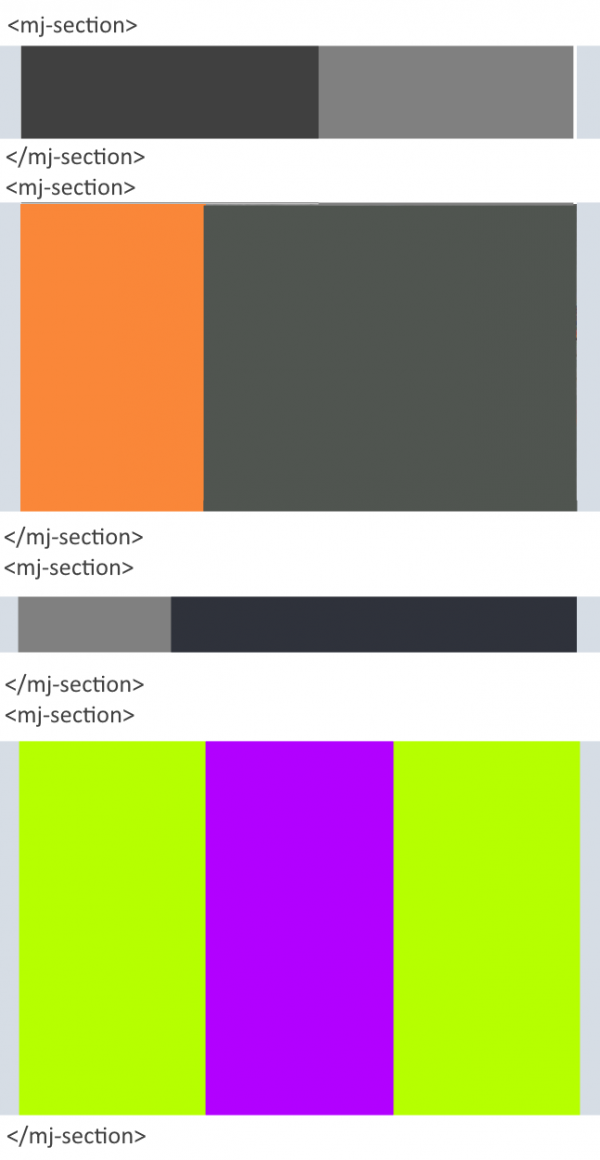

- #MJML SECTION HOW TO#
- #MJML SECTION INSTALL#
- #MJML SECTION FULL#
- #MJML SECTION CODE#
- #MJML SECTION DOWNLOAD#
# Watch template.mjml and auto-compile on every change. html, you need to open a terminal in the working directory and run one of the following commands: # Compile template.mjml into output.html Since we are making an email template, any external dependencies (mainly images) have to be included via CDN. It will contain all our markup and styles. This is the only file we will be working on. Create a new directory and add a template.mjml file.
#MJML SECTION INSTALL#
If you are using Atom or Sublime Text, there are also various helpful plugins that you can install if you want. Once you have that covered, open up a terminal window and install MJML globally, providing access to the mjml command.

To install it you will need to have Node.js on your machine, preferably v6.6.0 and above (we are using v6.9.5). The easiest way to get started with MJML is using the framework’s CLI. In real scenarios you want to have a template and some sort of system to generate newsletters every time you want to send one. The layout consists of four major sections:įor the sake of this tutorial we will fill the email with static dummy data.
#MJML SECTION DOWNLOAD#
The finished MJML template, as well as a compiled HTML version can be downloaded from the Download button near the top of the page. The Designįor a tasty example we will be making a simple pizza-themed newsletter. By constructing our template out of MJML components, we make sure that we won’t use any non-email-proof CSS properties or HTML tags. The framework offers a rich set of standardized components with various customization options. MJML on the left, Email-ready HTML on the right
#MJML SECTION CODE#
This way we don’t have to manually code entire layouts out of tables and legacy in-line styles. MJML provides a simple XML-like language that can be compiled to email-ready HTML.
#MJML SECTION HOW TO#
In this tutorial we will show you how to use the excellent MJML framework to make your own unique email templates.ĭisclaimer: This tutorial contains images of delicious food. One way to make email development easier is to use a framework which will take care of most of the above-mention issues. So yeah, just like making websites, only infinitely worse. The only difference is that layouts have to be constructed using, CSS styles have to be written inline, and you have to support clients so out of date, they use Microsoft Word for rendering. Making HTML emails is just like building websites. Sort of like Planet PHP or PHPDeveloper, except this site doesn’t look like it’s from the ’90s.Īll feeds Building Responsive Emails With MJML
#MJML SECTION FULL#
To see the full implementation using Node.This website aggregates the latest news and articles regarding PHP, and presents it in one place. What you have left is a dynamically generated rock solid email ready to be sent out!!! See it in Action MJML + Vue is: Awesome! Īdd some logic using Vue's template syntax. Start by creating an email template using MJML. MJML + Vue > Vue compiler > MJML compiler > Awesome HTML Email The Setup

Then the MJML can easily be compiled into HTML. The basic idea is to use Vue’s server-side renderer to populate an MJML template with data. So what if we used MJML instead of HTML? The Process As a result, we can set up a server to compile our Vue app into basic HTML. Thanks to the hard work of the Vue development team, we can take advantage of Vue’s server-side rendering capabilities. It wasn’t designed for email and, more importantly, you can’t run JavaScript in an email. At first glance, Vue probably doesn’t look that useful. Vue is a powerful javascript library for manipulating HTML. The SolutionĬreate a micro-service that uses Vue to render MJML. However, MJML, like many of the other email creation tools out there, does not provide us with an easy way of creating templates with dynamic data. MJML is a simple, lightweight markup language that creates consistent emails across all mail clients and devices. However, lucky for us, we have several tools at our disposal to make this process a little less painful. I’m looking at you Outlook! This lack of consistency can make building cross-platform compatible emails a complete nightmare. Today, some of the most popular mail clients don’t support basic web features Or worse, they choose to render HTML in unpredictable ways. Mail clients are still in the digital dark ages.


 0 kommentar(er)
0 kommentar(er)
